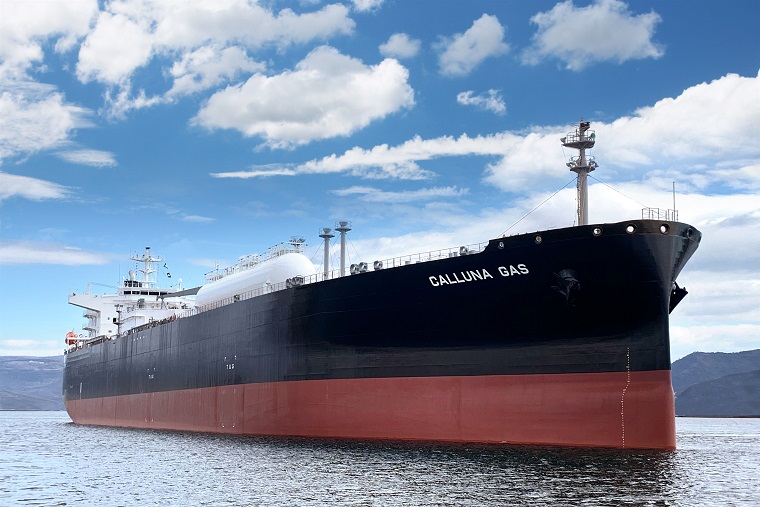LPG-fueled LPG carrier CALLUNA GAS Delivered
Feb. 28, 2022

Tokyo, February 28, 2022 — Kawasaki Heavy Industries, Ltd. announced today it has delivered the 84,000 m3 capacity liquefied petroleum gas (LPG) carrier CALLUNA GAS (Kawasaki hull No. 1751) for IINO KAIUN KAISHA, LTD. This is the 66th LPG carrier built by the company.
This vessel is a dual-fuel LPG carrier using LPG and low-sulfur fuel oil, and their third 84,000 m3 LPG carrier adopting a dual-fuel main engine.
In recent years, in order to effectively reduce emissions of greenhouse gases from international shipping, more vessels are adopting liquefied gases as an alternative to heavy fuel oil on a global scale. This very large LPG carrier is powered by LPG, which reduces greenhouse gas emissions and is expected to significantly reduce environmental impact. It is the fruit of the Kawasaki Group’s accumulated knowledge in building LPG and liquefied natural gas (LNG) carriers, and LNG-fueled vessels.
Kawasaki plans to develop and build more LPG-fueled LPG carriers and other commercial vessels that meet environmental standards, as well as to develop and offer other eco-friendly marine technologies, to contribute to the establishment of a low-carbon/decarbonized society. These products include vessels for transporting liquefied hydrogen, considered to be the next-generation energy source.
| Specifications | |
|---|---|
| Length overall | 229.90 m |
| Molded breadth | 37.20 m |
| Molded depth | 21.90 m |
| Molded draft | 11.60 m |
| Speed | Approx. 17.0 kn |
| Crew complement | 30 |
| Gross tonnage | 49,943 T |
| Deadweight | 55,086 t |
| Cargo tank capacity | 84,174 m3 |
| Main engine | One set of Kawasaki-MAN B&W 7S60ME-C10.5-LGIP diesel engine |
| Classification/country of registration | Nippon Kaiji Kyokai (ClassNK) / Panama |
| Delivery date | February 28, 2022 |
Features
- This LPG carrier operates using both LPG and low-sulfur fuel oil. Use of LPG as fuel greatly reduces emission volumes of sulfur oxides (SOx), CO2 and other pollutants compared with use of marine fuel oil. In this way, the new vessel will meet SOx emission standards*1 which were strengthened in January 2020, and EEDI*2 Phase 3 regulations which will further strengthen CO2 emission standards in 2022.
- In order to satisfy restrictions on NOx TierⅢ controls*3 emissions which is implemented by the International Maritime Organization (IMO), the main engine and generator are equipped with a Selective catalytic reduction (SCR) System, An exhaust gas purification system to reduce NOx, which allows the ship to navigate in Emission Control Area (ECA).
- Installation of LPG fuel tanks on the ship's upper deck makes it possible to load fuel-use LPG separate from the ship's cargo LPG. Moreover, a piping system connecting the LPG fuel tanks and LPG cargo tanks enables transferring of extra LPG to the LPG fuel tanks if necessary.
- This vessel adopts the Kawasaki rudder bulb system with fins (RBS-F) and the semi-duct system with contra fins (SDS-F) contribute to reducing fuel consumption.
Remarks
| *1 | SOx emission standards: Since January 2015, SOx emission restrictions in North American and European emission control areas (ECAs) have limited sulfur content in fuels to 0.1% or less. Starting in January 2020, regulations have required ships operating in all other parts of the world to use fuel with sulfur content levels of 0.5% or less, or alternatively use equipment to reduce SOx in exhaust gases to an equivalent level. |
| *2 | Energy Efficiency Design Index: Compulsory international regulations requiring energy-efficiency compliance in newly built ships based on EEDI values, which specify CO2 emissions in grams for transporting one ton of cargo for one mile. EEDI regulation values apply in increasingly strict phases based on the construction-contract conclusion date and finished-ship delivery date. Phase 3 regulations (30% CO2 emissions reduction compared with baseline levels) will be introduced for certain ship types including large LPG carriers and LNG carriers contracted to be built in 2022 or later. |
| *3 | The Tier III controls apply only to the specified ships while operating in Emission Control Areas (ECA), requiring 80% NOx emissions reduction compared with TierⅠcontrols. |
Related Link
Kawasaki Super Green Product (LPG Powered Large LPG Carrier)
https://global.kawasaki.com/en/corp/sustainability/green_products/Large_LPG_Carrier_2018.html
Contact
If you need more information about our business,
please feel free to contact us.





